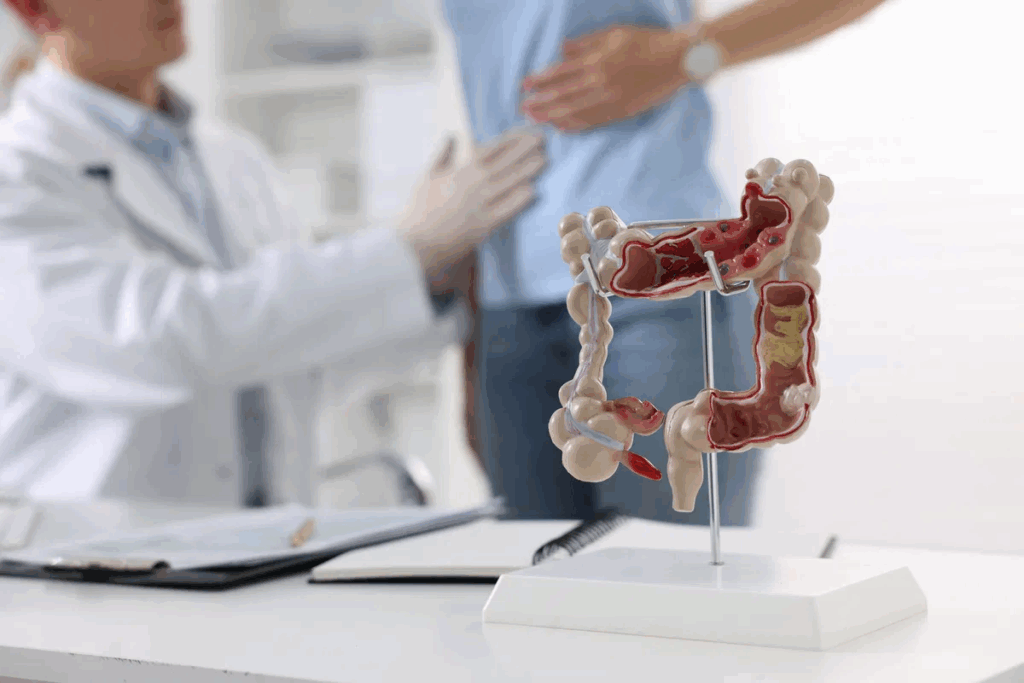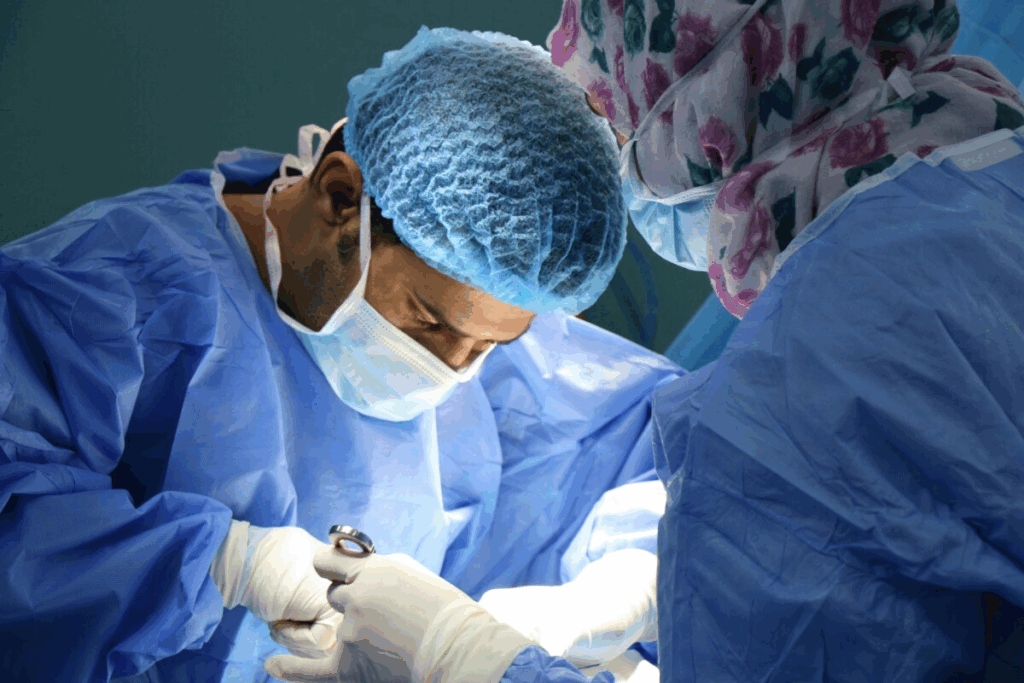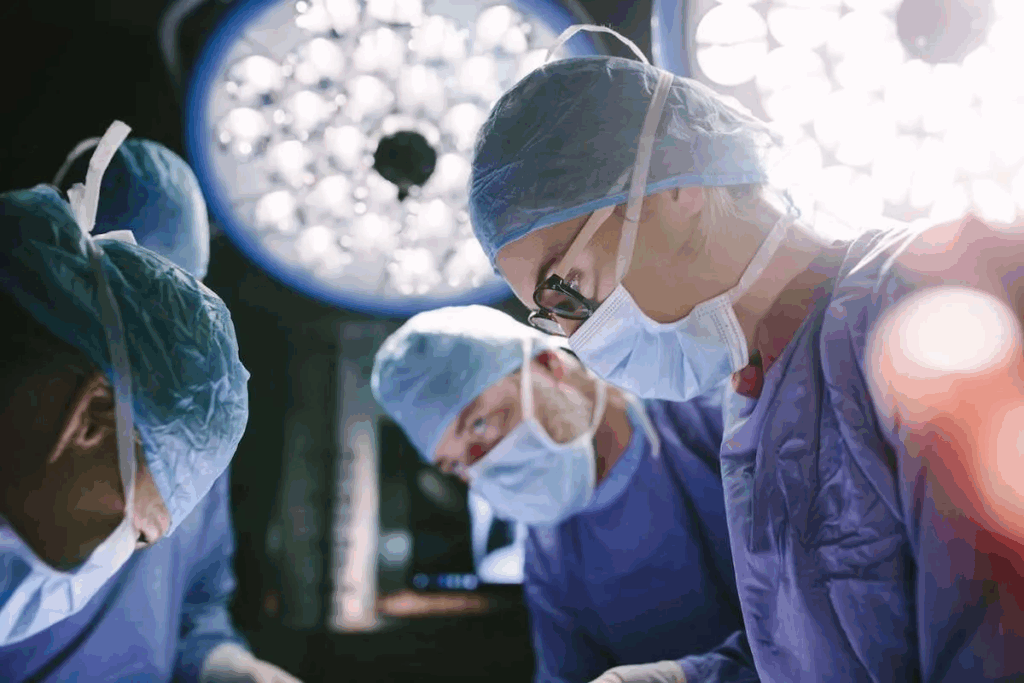Last Updated on October 30, 2025 by Bilal Hasdemir

Colorectal surgery is key in treating diseases of the colon, rectum, and anus. These surgeries use many techniques to tackle issues like cancer, inflammatory bowel disease, and benign disorders. Explore 8 essential colorectal operations and their roles in treating colon and rectal cancer.
At places like Liv Hospital, patients get a patient-centered approach and top-notch care. The team works together to provide the safest, most advanced colorectal surgical care.
It’s important for patients and families to know about the different colorectal surgery types. This helps them make better healthcare choices.

It’s key to understand colorectal diseases to know the right surgery. These diseases affect the colon and rectum. They need precise diagnosis and effective treatment.
Common diseases like colorectal cancer, inflammatory bowel disease (IBD), and diverticulitis may need surgery. These conditions can really affect a person’s life. So, getting the right treatment quickly is very important.
Many colorectal diseases need surgery. Here are some examples:
These examples show how important surgery is for treating colorectal diseases.
Getting a correct diagnosis is vital for planning surgery. The process includes:
| Diagnostic Tool | Purpose | Benefits |
| Colonoscopy | Direct visualization of colon and rectum | Identifies lesions and abnormalities |
| CT Scan | Detailed imaging of colon and surrounding structures | Assesses disease extent and spread |
| Biopsy | Tissue sampling for diagnosis | Confirms diagnosis and guides treatment |
Good surgical planning needs accurate diagnosis. This ensures the surgery fits the patient’s exact needs.

Colorectal surgery has changed a lot over the years. New medical technology and techniques have improved patient care. Now, patients recover faster and have a better quality of life after surgery.
For a long time, open surgery was the main way to treat colorectal problems. It involves a big cut in the belly to reach the colon or rectum. This method is good for complex surgeries but can cause a lot of pain and a long hospital stay.
Even with its challenges, open surgery is sometimes the best choice. It’s used for very complex cases where other methods can’t be used. Surgeons keep working to make it less painful and reduce risks.
Laparoscopic surgery changed the game in colorectal care. It uses small cuts and a camera to do surgery. This method causes less pain, leads to quicker healing, and shorter hospital stays.
“Laparoscopic surgery has revolutionized the field of colorectal surgery, providing patients with a less invasive option that promotes faster recovery and reduces the risk of complications.”
Dr. John Smith, Colorectal Surgeon
Laparoscopic surgery needs special training and tools but is now more common. It can be as effective as open surgery for some cancers. Plus, it has fewer side effects.
| Aspect | Open Surgery | Laparoscopic Surgery |
| Incision Size | Large (often 6-12 inches) | Small (typically 0.5-1 inch) |
| Recovery Time | Longer (often 6-8 weeks) | Shorter (typically 3-6 weeks) |
| Pain Level | Higher | Lower |
Robotic-assisted surgery is the newest step in making surgery less invasive. It uses a robotic system for more precise and controlled surgery. This method offers better views, less blood loss, and less pain after surgery.
The robotic system helps with detailed work and precise stitches. It’s great for surgeries like rectal cancer. While it costs more and takes longer, its benefits make it a good choice for patients and doctors.
As technology gets better, we’ll see more improvements in robotic surgery. This could make it even better for complex surgeries and improve patient care.
Colectomy is a surgery to remove part or all of the colon. It’s used for colon cancer, inflammatory bowel disease (IBD), and other severe colon issues.
Colectomy comes in two types: total and partial. Total colectomy removes the whole colon, often for FAP or severe ulcerative colitis. Partial colectomy takes out just the sick part, keeping the healthy parts.
| Type of Colectomy | Indications | Preservation of Colon |
| Total Colectomy | FAP, Severe Ulcerative Colitis | No |
| Partial Colectomy | Colon Cancer, Localized Disease | Yes |
There are different ways to do colectomy, like open, laparoscopic, and robotic surgery. The choice depends on the patient’s health, the disease’s extent, and the surgeon’s skill.
Recovering from colectomy means watching for problems, managing pain, and following care instructions. Patients are told about diet changes, wound care, and when to see the doctor again.
“The key to successful recovery lies in meticulous post-operative care and patient compliance with follow-up instructions.”
It’s important for patients to know about the different colectomy types and surgical methods. Choosing the right surgery can help them heal better and have better results.
Surgical treatments for colon diseases often include hemicolectomy. This procedure removes the affected colon segment. It’s a key surgery for treating colon cancer and inflammatory diseases.
A right hemicolectomy removes the right side of the colon. It’s used for colon cancer or severe right colon inflammation. The surgery cuts off the right colic artery’s supply area.
The surgeon carefully cuts and ties off blood vessels to the affected area. Then, they reconnect the colon to restore normal function.
Left hemicolectomy treats diseases on the left colon side. It’s often for left colon cancer or diverticulitis. The surgery removes the left colic artery’s supply area.
The surgeon mobilizes the colon, cuts blood vessels, and removes the diseased part. They then reconnect the colon to restore normal function.
For diseases beyond standard hemicolectomy, an extended hemicolectomy is needed. This removes a larger colon part, possibly including the transverse colon or other segments.
Extended hemicolectomy treats extensive colon cancer or complex inflammatory conditions. It requires careful planning to remove diseased tissue while preserving colon function.
| Type of Hemicolectomy | Indications | Key Steps |
| Right Hemicolectomy | Right-sided colon cancer, severe inflammation | Resection of right colon, ligation of right colic artery, reconnection of remaining colon |
| Left Hemicolectomy | Left-sided colon cancer, diverticulitis | Mobilization of left colon, division of left colic artery, resection of diseased segment, reconnection |
| Extended Hemicolectomy | Extensive colon cancer, complex inflammatory conditions | Removal of larger colon segment, potentially including transverse colon, careful planning to preserve colon function |
“The choice of hemicolectomy procedure depends on the location and extent of the disease, requiring a tailored approach to achieve optimal outcomes.”
— Colorectal Surgeon
Sigmoid colectomy is a surgery to remove the sigmoid colon. It’s needed for issues like diverticulitis or colon cancer. This surgery is key for treating lower colon problems that hurt a patient’s life quality.
Doctors decide on sigmoid colectomy for certain reasons. Diverticulitis, when the sigmoid colon’s wall gets inflamed, is a big reason. Also, colon cancer or big polyps in the sigmoid colon might mean it needs to be taken out.
Other reasons include:
A colorectal surgeon says, “Sigmoid colectomy is a key surgery for sigmoid colon issues. It helps patients feel better and live healthier.”
The surgery removes the bad part of the sigmoid colon and connects the rest. This can be done through open surgery or minimally invasive laparoscopic surgery. The choice depends on the patient’s health and the surgeon’s skill.
“The choice between open and laparoscopic surgery depends on various factors, including the complexity of the case and the patient’s overall health.”
After taking out the bad part, the surgeon connects the descending colon to the rectum. This keeps the bowel flowing right.
People who have this surgery often feel much better. It gets rid of pain, bleeding, and bowel changes.
Most patients get better quickly and can do normal things again in a few weeks. But, like any surgery, there are risks and side effects to talk about with a doctor.
“Most patients can go back to their usual diet and activities soon after surgery,” says a colorectal specialist. “They enjoy a better life.”
Low anterior resection is a key surgery for rectal cancer. It helps patients keep their quality of life good. This surgery removes the tumor and keeps the sphincter muscles, so patients can control their bowel.
The success of this surgery depends on careful techniques and clear surgical margins. Surgical margins are the tissue around the tumor removed during surgery. Clear margins help lower the chance of cancer coming back.
The surgery removes the tumor in the rectum and then connects the rest of the rectum or colon. Using total mesorectal excision (TME) helps remove all the fatty tissue around the rectum where cancer can spread.
The main goal of this surgery is to keep the sphincter muscles. This helps patients have normal bowel movements. But, it’s hard when the tumor is near the anal sphincter. Surgeons must look at the tumor’s location and the patient’s body to decide if they can keep the sphincter.
Before surgery, doctors use imaging and physical exams to plan. They decide if they can keep the sphincter based on the tumor’s size, location, and stage.
Low anterior resection syndrome (LARS) is a possible problem after this surgery. It causes bowel issues, urgency, and incontinence. Handling LARS needs a team effort, including diet changes, physical therapy, and sometimes medicine.
Doctors tell patients about dietary changes to help symptoms. Pelvic floor rehabilitation through physical therapy can also help with bowel control and quality of life.
It’s important for patients and doctors to know about the risks and benefits of this surgery. They should also understand LARS to make good treatment choices for rectal cancer.
Patients with early-stage colorectal cancers have a less invasive option: local resection. It’s great for those with small tumors that haven’t spread much. This method is less invasive than traditional surgery.
Transanal excision is a method for treating rectal tumors. It removes the tumor through the anus, avoiding big cuts. It’s best for small, early-stage rectal cancers.
There are different ways to do this, like:
These methods help remove the tumor carefully, with little harm to nearby tissues.
Endoscopic mucosal resection (EMR) is another technique for early-stage cancers. It uses an endoscope to remove the tumor from the lining of the colon or rectum.
EMR is good for:
It has the advantage of quicker recovery and fewer complications than big surgeries.
Choosing the right patients for local resection is key for good results. Doctors look at:
Research shows local resection works well for the right patients. It helps control the cancer and improves survival rates. It also keeps quality of life high.
In summary, local resection methods like transanal excision and EMR are good for early-stage colorectal cancers. By picking the right patients and using these methods, doctors can help patients live better and longer.
Strictureplasty is a key surgery for dealing with inflammatory bowel disease issues. It’s very helpful for Crohn’s disease patients. This is because the disease can cause the intestine to narrow, leading to blockages.
Strictureplasty is great because it keeps the bowel working well. Unlike removing parts of the intestine, it widens the narrow spots. This is good for patients with many strictures or those who’ve had surgery before.
Bowel preservation is key to keeping patients’ quality of life high. It helps avoid short bowel syndrome, a serious issue from losing too much intestine.
There are different ways to do strictureplasty, like Heineke-Mikulicz, Finney, and Michelassi methods. The choice depends on the stricture’s length, location, and the surgeon’s style.
Strictureplasty’s long-term results vary. It can help with blockage symptoms for a long time. But, strictures can come back, and some might need more surgery.
Recurrence rates depend on the method used and how severe the disease is. It’s important for patients to see a gastroenterologist regularly. This way, any problems can be caught and treated early.
Many surgical techniques are used to treat anal conditions. These include hemorrhoids, anal fistulas, and fissures. Each condition needs a specific surgical approach.
Hemorrhoidectomy removes swollen veins in the lower rectum or anus. It’s used for large, prolapsed, or treatment-resistant hemorrhoids.
Hemorrhoidectomy Techniques:
Anal fistulas are abnormal connections between the anus and skin. Surgery is needed to close the fistula and prevent it from coming back.
Anal Fistula Repair Methods:
Anal fissures are tears in the anus lining, causing pain and bleeding. Surgery is considered when other treatments don’t work.
Surgical Options for Anal Fissures:
| Surgical Procedure | Description | Benefits |
| Lateral Internal Sphincterotomy | Cuts a part of the internal anal sphincter to reduce spasms. | Heals fissures, reduces pain |
| Anal Dilation | Stretches the anus to relieve spasms. | Less invasive, promotes healing |
In conclusion, there are many surgical options for anal conditions. Each condition has its own treatment. It’s important for patients and doctors to understand these procedures for effective treatment.
Colorectal surgeons often perform ostomy procedures. These involve creating a stoma to redirect waste. This is done temporarily or permanently. It’s key for managing conditions like cancer, inflammatory bowel disease, and injuries.
The choice between a temporary or permanent ostomy depends on the condition and health of the patient. Temporary ones are used when the bowel needs to heal. Permanent ones are for more serious or chronic conditions.
Key differences between temporary and permanent ostomies:
Proper stoma care is vital for patient well-being. It includes regular cleaning, monitoring for complications, and using the right pouching systems. Patients and caregivers need to know how to manage the stoma well to avoid issues like skin irritation or leakage.
Effective stoma care includes:
For those with temporary ostomies, reversal procedures can restore normal bowel function. The decision to reverse an ostomy depends on several factors. These include the original reason for the ostomy and the patient’s current health status.
| Procedure | Description | Considerations |
| Colostomy Reversal | Reconnection of the colon to restore normal bowel function | Patient’s overall health and bowel condition |
| Ileostomy Reversal | Reconnection of the ileum to the rectum or anus | Presence of any complications or disease recurrence |
Understanding ostomy procedures is key for patients undergoing colorectal surgery. By providing thorough care and education, healthcare providers can enhance patient outcomes and quality of life.
It’s important for patients to know the risks of colorectal surgery. This knowledge helps them make better choices about their health. Like any surgery, colorectal procedures can have risks and complications.
Complications after colorectal surgery can be serious. They can affect how well a patient recovers. Here are some common ones:
These complications show why choosing the right patient, using careful surgical techniques, and good post-operative care are so important.
Colorectal surgery can also affect a patient’s life long-term. It can change how well they function and their quality of life. Some possible effects include:
Knowing about these long-term effects is key for patients to get ready for life after surgery.
Getting ready for colorectal surgery is important. It involves medical checks, lifestyle changes, and eating right. Knowing what to do can make a big difference in your surgery experience.
Before surgery, you’ll get checked thoroughly. This includes looking at your health history, a physical check, and tests like blood work and imaging. You might also get an ECG if you’re older or have certain health issues.
These tests find any risks or problems so the surgery team can plan just for you. It’s important to tell them about all your medicines, supplements, and allergies.
| Test | Purpose | Typical Findings |
| Blood Work | Evaluate overall health, detect anemia or infection | Complete Blood Count (CBC), Blood Chemistry |
| Imaging Studies | Visualize the colon and surrounding tissues | CT Scan, MRI, or Barium Enema results |
| Electrocardiogram (ECG) | Assess heart health | Heart rate, rhythm, and possible problems |
Cleaning your bowel before surgery is key. You’ll follow a special diet, take laxatives, and might use enemas. You’ll eat only clear liquids for a day or two before surgery and drink a bowel prep solution.
Following these steps is very important for a good surgery. Listen carefully to your healthcare team to make sure your bowel is clean.
Eating right is important before and after surgery. You might eat more protein and certain nutrients before to help heal. After surgery, start with clear liquids and soft foods and gradually go back to normal eating.
Eating well can help you heal faster and avoid problems. Talk to your doctor or a dietitian for advice on what to eat.
The field of colorectal surgery has seen big changes in recent years. These changes have made care for various colorectal conditions better. Now, thanks to new surgery methods, patients have shorter recovery times, less pain, and better results.
A colorectal surgeon is key in giving specialized care to patients. Knowing about these surgery advances helps patients make better choices. This way, they get the best care possible.
Thanks to these changes, patients are getting better results and living better lives. As technology keeps getting better, colorectal surgery will likely get even more effective. This brings new hope to those with colorectal diseases.
By keeping up with the latest in colorectal surgery, patients and doctors can work together. This teamwork leads to the best treatment results.
Subscribe to our e-newsletter to stay informed about the latest innovations in the world of health and exclusive offers!
WhatsApp us